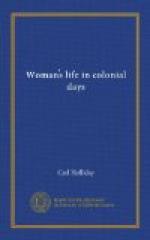[69] Ibid., Vol. I, p. 344.
[70] Smyth: Vol. III, p. 431.
[71] Smyth: Vol. V, p. 345.
[72] Quoted in Earle’s Child Life in Colonial Days, p. 113.
[73] Humphreys; Catherine Schuyler, p. 75.
[74] Brooks: Dames and Daughters of Colonial Days, p. 199.
CHAPTER III
COLONIAL WOMAN AND THE HOME
I. The Charm of the Colonial Home
After all, it is in the home that the soul of the colonial woman is fully revealed. We may say in all truthfulness that there never was a time when the home wielded a greater influence than during the colonial period of American history. For the home was then indeed the center and heart of social life. There were no men’s clubs, no women’s societies, no theatres, no moving pictures, no suffrage meetings, none of the hundred and one exterior activities that now call forth both father and mother from the home circle. The home of pre-revolutionary days was far more than a place where the family ate and slept. Its simplicity, its confidence, its air of security and permanence, and its atmosphere of refuge or haven of rest are characteristics to be grasped in their true significance only through a thorough reading of the writings of those early days. The colonial woman had never received a diploma in domestic science or home economics; she had never heard of balanced diets; she had never been taught the arrangement of color schemes; but she knew the secret of making from four bare walls the sacred institution with all its subtle meanings comprehended under the one word, home.
All home life, of course, was not ideal. There were idle, slovenly women, misguided female fanatics, as there are to-day. Too often in considering the men and women who made colonial history we are liable to think that all were of the stamp of Winthrop, Bradford, Sewall, Adams, and Washington. Instead, they were people like the readers of this book, neither saints nor depraved sinners. In later chapters we shall see that many broke the laws of man and God, enforced cruel penalties on their brothers and sisters, frequently disobeyed the ten commandments, and balanced their charity with malice. Then, too, there was an ungentle, rough, coarse element in the under-strata of society—an element accentuated under the uncouth pioneer conditions. But, in the main, we may believe that the great majority of citizens of New England, the substantial traders and merchants of the middle colonies, and the planters of the South, were law-abiding, God-fearing people who believed in the sanctity of their homes and cherished them. We shall see that these homes were well worth cherishing.
II. Domestic Love and Confidence




